

President's Budget Would Boost Science Funding
ALS Sheds Light on Archaeological Mysteries and Other Puzzles
President's Budget Would Boost Science Funding
Federal science funding of energy research and the physical sciences is a winner in President Bush's FY2007 budget request to Congress. Berkeley Lab's Department of Energy funding is expected to increase as a result. Over the next several months the President's request will be debated by Congress, and final funding decisions will be included in the 12 annual appropriations bills, typically enacted mid to late fall, that fund all federal expenditures. Although the President's request appears good for the Office of Science, the process is just beginning and Congress will address its particular priorities through the appropriations process.
Within the President's $2.7 trillion FY2007 budget proposal, the request for DOE is $23.6 billion, approximately level with FY2006. However, the Office of Science would receive one of the largest percentage increases in the federal budget, 14.1 percent, for a total of $4.1 billion. According to estimates by the Department of Energy, Berkeley Lab's annual DOE budget would increase by approximately 12 percent.
The good news for the physical sciences and energy research was released on February 6, following the announcement a week prior in the President's State of the Union Address of two new national “competitiveness” initiatives. Recognizing that “through America's investments in science and technology, we have revolutionized our economy and changed the world for the better,” President Bush announced that the American Competitiveness Initiative would double funding in ten years for the physical sciences at DOE's Office of Science, the National Science Foundation and the National Institutes for Standards and Technology, reversing a trend that foretold extremely tough budget years ahead.
Also announced was the Advanced Energy Research Initiative which calls for a 22 percent increase in the research and development of alternative energy sources and energy storage technologies. The Office of Science budget incorporates $539 million in funding for this initiative in nuclear fusion, solar, biomass and hydrogen research programs, including solar-to-chemical fuel and other areas central to Berkeley Lab's scientific objectives.
In addition to funding the President's new initiatives, the Office of Science budget addresses laboratory infrastructure. Improving and replacing old and outdated facilities has long been a priority of the Congress and of the Office of Man-agement and Budget. The increases to the Office of Science's budget provide the flexibility needed to make progress in this area. Consequently, Berkeley Lab will receive $7.5 million in new money for seismic upgrades to buildings 50 and 74. The budget also increases the amount of money available for the demolition of the Bevatron by $3 million over FY2006 to $14 million. This increase will allow the Bevatron project to move forward as planned.
In the Lab's scientific programs, several areas are budgeted for funding increases. Computational science areas will see the largest increases. The National Energy Research Scientific Computing Center is slated for a $17.3 million increase over FY2006, bringing the total budget to $54.8 million. DOE officials within the Office of Advanced Scientific Computational Research announced that one of the operational goals of the proposed budget is that NERSC peak in the 100 to 150 teraflop range by the end of FY07.
ESnet, the Energy Sciences Network, which Berkeley Lab manages for the Office of Science, is budgeted for an increase of $3.7 million, bringing the total requested budget for FY2007 to $22.7. The goal for this increase is that ESnet will deliver a backbone network with two to four times the capability of today's network, to support the science mission of the Department.
With the Molecular Foundry opening later this year, the President's budget request includes $19.2 million in operation funding for the Foundry in FY2007, up $12 million over FY2006. Other national user facilities at the Lab will see increases as well. The Advanced Light Source is scheduled to receive $49.8 million, a $7 million increase. The Lab will also receive $3.4 million in funding to begin the planning process for building a new support facility for the ALS that would include significant high-bay space for staging experiments and offices for scientific staff.
ALS Sheds Light on Archaeological Mysteries and Other Puzzles
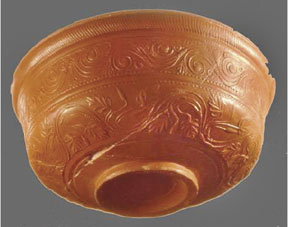
Gallo-Roman terra sigillatas pottery boasts a rich red gloss or slip, the origin of which has baffled archaeologists.
Qin Shihuang was the first Emperor of China, a conqueror of many lands who founded a dynasty and began construction of the Great Wall. When he died in 210 B.C.E., a mighty army of several thousand soldiers was fashioned out of terra-cotta clay and buried in his mausoleum to accompany the emperor into battle after death. The terra-cotta from which this life-sized spirit army was made bears a unique purple pigment that has endured through the ages. How the ancient Chinese craftsmen were able to produce this purple dye has remained a mystery.
The terra sigillata pottery produced in the first century C.E. under the reign of Caesar Augustus at the workshops in La Graufesenque, France, is famous for its rich red gloss or slip. While the chemical and mineral composition of Gallo-Roman terra sigillata pottery has been extensively analyzed, the brightness and color of its slip has remained a mystery.
New light on these ancient archaeological puzzles is being shed by Beamline 7.3.3 at Berkeley Lab's Advanced Light Source (ALS) through the use of a technology known as scanning x-ray microdiffraction. Under the leadership of ALS scientist Nobumichi Tamura, white or monochromatic microbeams of x-rays, scanned across minute amounts of crystalline samples, generate interference patterns that provide structural information at submicroscopic levels. Such detailed information gives archaeologists a unique look at the history as well as the composition of these samples.
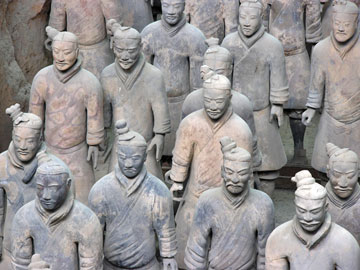 A spirit army of terra-cotta soldiers, each with a unique face, was created to accompany Chinese Emperor Qin Shihuang into battle after his death. The soldiers were dyed with a purple pigment now lost to the ages.
A spirit army of terra-cotta soldiers, each with a unique face, was created to accompany Chinese Emperor Qin Shihuang into battle after his death. The soldiers were dyed with a purple pigment now lost to the ages.
“Beamline 7.3.3. is one of the first of its kind in the world,” said Tamura. “It combines the use of white and monochromatic light focused to a spot less than a micron in size so that we can perform x-ray diffraction experiments with very high spatial resolution.”
When an x-ray beam passes through a crystal, the atoms in the crystal cause the waves of x-rays to interfere with one another as they exit the crystal. These interference patterns can be detected and analyzed to show how the atoms in the crystal are arranged.
“Scanning x-ray microdiffraction allows us to obtain valuable clues as to how a sample material was made,” Tamura said. “With the combined use of a white microbeam and two-dimensional detector technology, we can illuminate and map different zones in a sample without the need of rocking the sample, as in conventional x-ray diffraction techniques. This saves a lot of time.”

ALS scientist Nobumichi Tamura is responsible for Beamline 7.3.3., one of the few beamlines in the world that enables researchers to perform high-resolution x-ray microdiffraction.
ALS Beamline 7.3.3 is powered by a bend magnet, which can generate x-rays in the 6 to 12 thousand electron volt range. Capabilities at this beamline include high-resolution mapping of grain orientation and structure, stress and strain, plastic deformation, and phase distributions in heterogeneous samples. Microdiffraction scans can be performed with white or monochromatic beams, depending on whether the grain size of a sample material is the same or greater than the x-ray beam size (white), or much smaller than the x-ray beam size (monochromatic).
The detective capabilities of ALS Beamline 7.3.3 have been applied to scientific puzzles that extend far beyond archaeological mysteries. For example, they have been used to track the location of heavy metals in contaminated soils and to study deformations in microchips that arise as a result of electromigration. Biomaterials, superconductors, thin films, fuel cells and MEMS have also been studied there.
“One week I work on the micro-structure of deep sea coral, the next on some interplanetary dust particles, and the following week on terra sigillatas, “ said Tamura. “This is scientifically a very interesting job!”
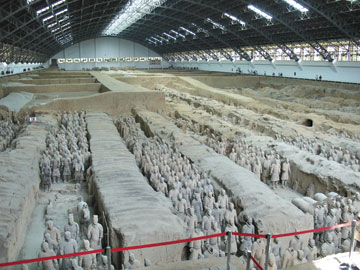 The first underground pit containing the terra-cota spirit army of Emperor Qin Shihuang was excavated in 1976, outside of the Chinese city Xi'an. There were nearly 6,000 clay soldiers buried in this pit, which covered an area of almost four acres. Three other smaller pits were subsequently discovered.
The first underground pit containing the terra-cota spirit army of Emperor Qin Shihuang was excavated in 1976, outside of the Chinese city Xi'an. There were nearly 6,000 clay soldiers buried in this pit, which covered an area of almost four acres. Three other smaller pits were subsequently discovered.
While the investigation into the recipe behind the purple pigment of Emperor Qin's terra-cotta army is still on-going, the terra sigillatas study has already yielded intriguing results.
“The red color comes from the presence of iron oxide, mostly hematite,” said Tamura. “The shiny aspect of the slip is correlated with the presence of small grain-sized corundum, an aluminum oxide. Later versions of the terra sigillatas that did not have the corundum showed a poor quality slip.”
Microdiffraction work at the ALS is scheduled to be moved this coming summer from Beamline 7.3.3 to Beamline 12.3.2, which is powered by one of the new superconducting bend magnets, or “superbends.” With increased beam flux and smaller beam size, the new station will be able to find even more subtle clues for solving future mysteries, said Tamura, who will be moving as well to head the work at Beamline 12.3.2.
Caitlin Elizabeth: Lady of the Elven Lands
After a seven-year gestation period, Caitlin Youngquist's prize progeny emerged this month. The beautifully delicate work, featuring the young Berkeley Lab designer's lilting vocals and haunting cello, goes by the name “In Elven Lands: The Fellowship.” If that sounds like a spinoff from Tolkien's Lord of the Rings, it's no accident.
“This is 'new early' music, kind of folk-classical,” Cait Youngquist said. “It's hard to characterize. The genre is unclear. But it is based on legends from the Tolkien universe and our interpretation of songs mentioned (in Tolkien's fantasy literature). It has a high 'geek' factor.”
The CD's journey to production was almost as difficult as a hobbit's road through Middle Earth.
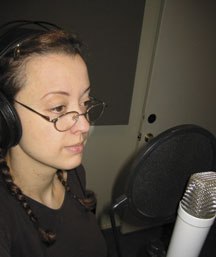
Caitlin Youngquist, at work in the recording studio
Youngquist — referred to on the CD as “Caitlin Elizabeth”— comes from a distinguished and eclectic musical pedigree. Her mother, a USC administrator, plays lute (a guitar-like stringed instrument). Her dad, an advertising and marketing executive, sings and plays guitar. Her sister is in musical theatre. Her grandmother inspired the song “Splish Splash” by Bobby Darin and wrote the music for it. Her grandfather is the late Murray the K, the famous 1960s rock impresario and disc jockey who discovered Darin and escorted the Beatles on their initial U.S. tour.
With those influences, it's no wonder the former Caitlin Altschuler of Brooklyn followed a musical muse. Her Los Angeles-area upbringing helped, too, and when she connected with composer Carvin Knowles at age 17, her English folk-styled fate was sealed.
“I met Carvin at the Renaissance Faire (in Glen Helen) in 1988 when I was 17,” said Youngquist, her jet-black short hair and glasses reflecting her distinctive artistic style. “I asked him how to tune a lute. From there, I joined his group 'Drake's Winds' and played the Faire for seven years.”
She contributed to more contemporary bands over the years — the “pre-industrial” Houndes and the more rock-styled Moya. But when Knowles called her about a project that grew from his failed attempt to score the “Lord of the Rings” movies — and one that had the involvement of Yes lead vocalist Jon Anderson — she jumped at the chance to return to the olde English madrigal style that characterizes “In Elven Lands.”

It wasn't easy. From the first rehearsal and demo recording in 1999, through more than 20 treks to the L.A. recording studio and the 14-hour days and nights, through the learning of dialects (Elven and Dwarven) that she neither understood nor could translate, Youngquist partnered with Knowles through their difficult labor of love. The result, described as “inspired by the writings of J.R.R. Tolkien,” is an homage to the author's fertile imagination and idyllic world.
Knowles would go off to compose for movies like “American Pie,” “Porn Star: the Legend of Ron Jeremy,” and the forthcoming “Strangers with Candy.” Anderson would reunite and tour with Yes. Youngquist would graduate from Mills College in creative writing and literature, thrive as one of the Lab's talented designers in Creative Services, and begin a nascent business making hand-crafted wool felt pillows and handbags (“The Pillow Project”) from the Oakland loft she shares with ex-Lab photographer Robert Couto.
But the long-in-the-making soundtrack for the land of elves and dwarves will live on, if only on Amazon.com and for the special few who come to appreciate the beauty of Caitlin Elizabeth's voice and instrumentation. Listen at http://img-nex.theonering.net/ sounds/Tir_Im.mp3
SNAPSHOT: An inside look at one of the Lab's many interesting employees�
Name
Dr. Peter Lichty
Job
Occupational Medical Director
Childhood Ambition
To become a physician
Weirdest Job
Investigating an outbreak of rashes on an offshore oil production platform in the Gulf of Mexico
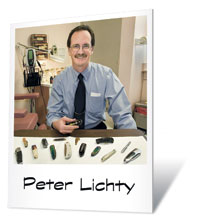
Guilty Pleasure
Collecting pocket knives
Hero
Ted Benell, family physician and maritime medicine doctor
Proudest Moment
Dancing in the Nutcracker party scene with my daughters
Last Book Read
Reading People, by Jo-Ellan Dimitrius, Mark C. Mazzarella
Current Tunes on iPod or CD Player
Duruflé Requiem
Favorite Movie(s)
Blue
When Not Working
I like to turn wood on a lathe…and grow tomatoes
Ideal Vacation
Banff
Energy to Burn:
Carolyn Bertozzi, New Director of the Molecular Foundry
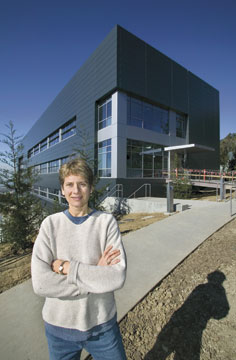 Carolyn Bertozzi, outside of the Molecular Foundry
Carolyn Bertozzi, outside of the Molecular Foundry
Carolyn Bertozzi is a distinguished professor of chemistry at UC Berkeley, a member of the National Academy of Sciences, a Howard Hughes Medical Institute Investigator, a MacArthur Foundation Fellow, author of 150 papers, holder of 16 patents, and recipient of too many prestigious teaching awards and other honors to list. Her lab takes up almost a full floor of Latimer Hall and her research group numbers over four dozen. Berkeley Lab director Steven Chu recently named her to direct the Molecular Foundry, where she already heads the Biological Nanostructures facility. And she hasn't yet turned 40.
So how does she manage to stay modest? “I was not a kid who was brilliant at one thing,” Bertozzi says. Back in 1999, when the MacArthur Foundation called to tell her she'd won what many consider the “genius award,” she thought they'd mistaken her for her sister Andrea, now a math professor at UCLA. “My first reaction was, they got the wrong Bertozzi.”
Growing up in Massachusetts she was too impatient to take lessons in anything, whether sports or music, preferring to dive right in. She picked up the piano by ear and when she got to Harvard, she sang and played keyboard in a rock group called Bored of Education — in her case, a profound misnomer. For it was while at Harvard that Bertozzi discovered the subject, organic chemistry, that fired her imagination and became the core of her research career. In 1988 she graduated summa cum laude.
During graduate work at Berkeley — where she earned her Ph.D. in 1993 — and postdoctoral research in the immunology program at UC San Francisco, Bertozzi's interests became focused on the intersection of biology and chemistry, especially the surfaces of cells.
In 1997, a year after Bertozzi joined Berkeley Lab's Materials Sciences Division (MSD), she and her students published a paper in Science describing a method for inducing cells to express special markers in the complex sugars that decorate their surfaces. The sugars remained functional and could, for example, signal the condition of the cells that displayed them. But they also showed promise for cellular engineering, forming bonds with diagnostic agents, specific drugs, and even nonbiological materials, the beginnings of “cellular cyborgs.”
With the invention in 2000 of the Staudinger ligation, a means of linking cell-surface sugars and other molecules with purely nonbiological materials (named after a classic reaction she first learned about in undergraduate chemistry class), Bertozzi's cellular-engineering arsenal gained new power. In 2004 she and her colleagues engineered the surfaces of cells in mice, a first in living animals.
An eager collaborator, Bertozzi has pursued numerous other studies at the frontier where chemistry and biology meet, including bone substitutes, better contact lenses, artificial tissues, and neural networks using real nerves. Along with MSD and her university research, she's a member of the Lab's Physical Biosciences Division. Meanwhile her teaching and mentoring of students at all levels have never flagged. Directing the Molecular Foundry may be Bertozzi's biggest challenge yet, but it's unlikely to slow her down.
Tech Transfer Success Hunts for Hydrocarbons
What does it take to shepherd an idea from the drawing board to the marketplace? Patience, hard work, and a little luck, according to Greg Newman of the Earth Sciences Division. He recently won a 2005 Excellence in Technology Transfer Award for developing software that is used in electromagnetic modeling of offshore hydrocarbon reservoirs.
The software has been licensed to several oil and gas exploration companies such as Shell, ConocoPhilips, and a Norwegian company that uses the software to search for underwater hydrocarbon deposits. Over the past two years, these licenses and associated research funds from the oil and gas industry have brought in nearly $1 million in revenue to Berkeley Lab.
“These companies have used the software to locate reservoirs that otherwise would be difficult to detect with existing technology. It has also been used to determine that some promising sites detected by other methods were in fact not hydrocarbon reservoirs,” says Newman.
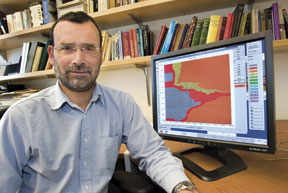
Greg Newman of Earth Sciences with his software for modeling hydrocarbon reservoirs.
Newman has been developing large-scale electromagnetic and imaging software for 20 years, mainly at Sandia National Laboratories. In 2004, Newman left Sandia to join Berkeley Lab. The Lab's Technology Transfer Department entered into an arrangement with Sandia to allow Berkeley Lab to license the codes Newman developed at Sandia, as well as allow Newman to continue to develop the codes.
His software deciphers the signals captured from electromagnetic imaging of offshore hydrocarbon reservoirs, which are pockets of oil, gas, brine, or water located under the seabed. In this process, a ship-towed transmitter sends electromagnetic signals into the sea floor. Some of the fluids within a hydrocarbon reservoir, such as oil, are insulators, so they resist the signals. Other fluids are conductive, such as water and brine. Detectors located on the sea floor gather the electromagnetic signals after they've traveled through a reservoir, giving geophysicists an indication of what it holds.
“But it is very difficult to interpret what these signals mean just by looking at the raw signals, so we developed a processing package that takes the signals and produces three-dimensional maps of the substrata,” says Newman.
The technology is meant to augment — not replace — current imaging techniques such as seismic imaging. It will allow scientists to tease out ever more subtle signatures of hydrocarbons from geologically challenging sites.
Newman traces the software's success to a few milestones. In the early 1990s, he received Office of Science (Basic Energy Sciences) funding and Laboratory Directed Research and Development funding for separate projects to aid the transition of his modeling and imaging codes from serial computers to high-performance, distributed computing platforms. More funding came in 1999, when he got a call from ExxonMobil representatives who were interested in using the software to produce very detailed images of offshore sites.
Newman and colleagues, such as fellow Earth Sciences Division staff scientist Mike Hoversten and postdoctoral fellow Michael Commer, are currently working to increase the code's scale so it can map large basins that measure 2500 square kilometers. Ultimately, it is one more valuable tool in the push to secure reliable sources of energy.
“This technology will help buy us time as we seek renewable energy alternatives,” says Newman. “One must be dedicated to seeing that the technology being transferred is going to be a success. Be proactive and work with the lab's Technology Transfer people. They are a there to help your technology succeed, but you must take the lead.”
Forging a National Laboratory System in a Time of Peril
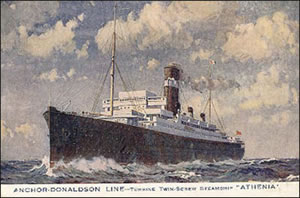
The passenger liner Athenia.
On September 1, 1939, Germany invaded Poland. On September 3, France and Great Britain declared war on Germany; on the same day a German submarine torpedoed and sank the passenger liner Athenia off the coast of Scotland, with the loss of 118 lives. Ernest Lawrence's brother John, returning from Europe, was the last person into a lifeboat after saving others.
There were rumors from Stockholm that no Nobel Prizes would be presented in 1939. But on November 9 the Associated Press announced that Lawrence had won “for the invention and development of the cyclotron and for results obtained with it, especially with regard to artificial radioactive elements.” Eventually his medal and certificate arrived at the Swedish consulate in San Francisco, to be presented at a University of California ceremony on February 29, 1940.
The Palomar of the Infinitesimal
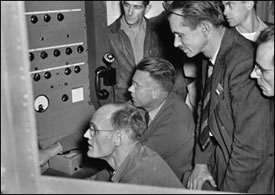 First beam of 184-inch cyclotron, November 1, 1946; foreground, left to right, R. Thornton, Ernest Lawrence, Ed McMillan, and James Vale.
First beam of 184-inch cyclotron, November 1, 1946; foreground, left to right, R. Thornton, Ernest Lawrence, Ed McMillan, and James Vale.
Lawrence used the occasion to promote his dream of a cyclotron that could accelerate protons to 100 million electron volts (100 MeV). Its vacuum chamber would be wider than Mount Palomar's 200-inch mirror, and its magnet would weigh 3,000 tons — or maybe 4,000 tons, or maybe more — and cost three-quarters of a million dollars. Or maybe one-and-a-quarter million. Or maybe more. The university would have to raise the money from private sources, but a Nobel Prize made that seem possible.
Some scoffers objected that nothing very significant had been done with Lawrence's cyclotrons, an objection put firmly to rest in the summer of 1939 when Luis Alvarez and Robert Cornog, using the 60-inch cyclotron, discovered stable helium-3 — which every scientist believed should be radioactive — and a few days later used the 37-inch cyclotron to make radioactive hydrogen-3, better known as tritium — which every scientist thought should be stable.
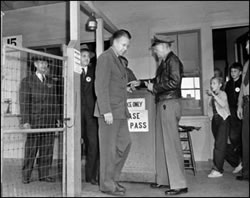
Ernest O. Lawrence challenged by a security guard at the wartime Laboratory.
Close on these discoveries came Martin Kamen's work with carbon isotopes with both the 37-inch and 60-inch cyclotrons, leading to his discovery of radioactive carbon-14 on February 27, 1940 — two days before Lawrence's Nobel Prize ceremony, at which the discovery was announced.
More significant than sour grapes about the cyclotron's worth were scientific warnings about its physical limitations. Because its speed increases as its orbit widens, a particle spiraling in a cyclotron's magnetic field stays in sync with the alternating electric field that accelerates it. But as it approaches the speed of light, the particle's mass also increases, eventually throwing the beam out of focus.
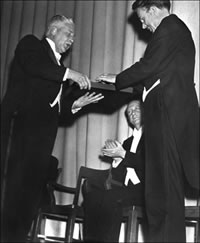 Nobel Prize ceremony for E.O. Lawrence, 1940, held at Wheeler Hall, UC Berkeley due to WWII; awarding the prize is the Swedish Consul General.
Nobel Prize ceremony for E.O. Lawrence, 1940, held at Wheeler Hall, UC Berkeley due to WWII; awarding the prize is the Swedish Consul General.
Hans Bethe was the first to raise the specter of a cyclotron's “relativistic limit,” which James Chadwick estimated at “about 10 million volts for protons, 15 million volts for deuterons and alpha particles.” This pessimistic guess was left in the dust as Robert Wilson, Edwin McMillan, Donald Cooksey and others among Lawrence's boys continually came up with clever ways to shape magnetic fields and keep cyclotron beams focused.
Still, a 100-MeV cyclotron seemed to defy the laws of nature. Historians J.L. Heilbron and Robert W. Seidel write that Lawrence “bruited a solution in the style of the Old West: put a million or two volts on the dees and drive the beam home before it knows it has been defocused.”
Lawrence's confidence was enough to persuade his fans, who included, among many others, Warren Weaver, director of the Rockefeller Foundation's Division of Natural Sciences. In the spring of 1940 the Rockefeller Foundation agreed to fund the new machine to the tune of $1.4 million. It would be a 184-inch cyclotron, to be built on Charter Hill overlooking the Berkeley campus; its magnet would weight 4,500 tons, and for safety its controls would be located 150 feet away.
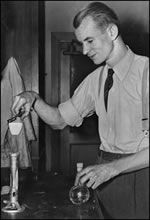
Ed McMillan recreating the search for neptunium at the time of the announcement of the discovery, June 8, 1940.
To house it, distinguished architect Arthur Brown, whose works included San Francisco's City Hall, Opera House, and Coit Tower, designed a 90-foot-high dome. This was an aesthetic advance over Lawrence's original inspiration. While entertaining visitors at the Folies Bergère during the Golden Gate International Exposition on Treasure Island, Lawrence had become distracted by the steel-framed dance hall and inquired whether the university might acquire it to house his new cyclotron when the Exposition closed.
The Uranium Problem
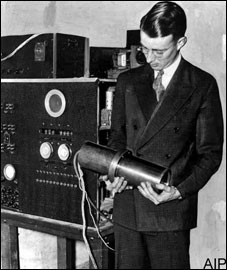 Luis Alvarez, one of �Lawrence's Boys,� circa 1938.
Luis Alvarez, one of �Lawrence's Boys,� circa 1938.
In the spring of 1940 construction of the giant cyclotron began in earnest; meanwhile Lawrence became increasingly worried about the war. His reasons went deeper than the Wehrmacht's conquests in Europe. Back in January 1939, Luis Alvarez had been sitting in a barber's chair reading the San Francisco Chronicle when, buried deep inside it, he found an article reporting Niels Bohr's announcement that German chemists had split the uranium nucleus.
“I stopped the barber in mid-snip and ran all the way to the Radiation Laboratory to spread the word,” Alvarez recalled. A year and a half later Ed McMillan and Philip Abelson used the 60-inch cyclotron to bombard uranium with neutrons, creating element 93, which McMillan named neptunium. By February, 1941, Glenn Seaborg, J.W. Kennedy, and graduate student Arthur Wahl, continuing McMillan's work and aided by Emilio Segrè, had made and purified element 94. A year later Seaborg named it plutonium; he intended the symbol Pu as a comment — pee-yew — but nobody got the dark humor.
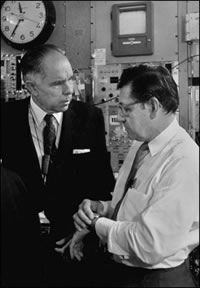 Glenn Seaborg (left) and Albert Ghiorso.
Glenn Seaborg (left) and Albert Ghiorso.
War work initially had nothing to do with transuranic elements or nuclear fission, however. “I am puzzled as to what, if anything, ought to be done in this country in connection with it,” Vannevar Bush wrote in May 1940, shortly before Roosevelt commissioned him to head the National Defense Research Committee to work on war problems. The first act of the committee was to recruit “cyclotroneers,” thought to be “ideal for crash programs,” of which the most urgent was radar.
In November of 1940 Lawrence sent some of his best people, including Alvarez and McMillan, to MIT's Radiation Laboratory — so named partly to honor Lawrence and partly to “confuse the enemy” — where they would help perfect radar in many forms. But when NDRC asked Lawrence to jump-start a parallel effort, the Navy's Anti-Submarine Warfare Unit in San Diego, he did so chiefly by persuading McMillan to leave the MIT Rad Lab; McMillan's contributions were to prove crucial to the development of sonar.
In early 1941 the war had not yet completely engulfed Berkeley's Rad Lab. Steel executive William H. Donner, whose son had died of cancer, gave $165,000 to fund the Joseph W. Donner Laboratory, initially intended for John Lawrence's research in nuclear medicine; ground was broken in June. But Lawrence's worries about fission soon found a focus. “It will not be a calamity if, when we get the answers to the uranium problem, they turn out to be negative from the military point of view,” he said, but if positive, “and we fail to get them first, the results for our country may well be tragic disaster.”
 The magnet yoke for the 184-inch cyclotron during construction.
The magnet yoke for the 184-inch cyclotron during construction.
Lawrence had the 37-inch cyclotron converted into a mass spectrograph to see how well it could magnetically separate fissile U-235 from chemically identical U-238. He suggested that plutonium, then made only in the 60-inch cyclotron, would also be fissile and could be produced in a nuclear reactor, provided one were ever built.
On December 6, 1941, one day before the Japanese attacked Pearl Harbor, the 37-inch cyclotron succeeded in separating a few micrograms of fissionable U-235 from heavier U-238. Two weeks later the government gave Lawrence's lab $400,000 to investigate magnetic separation. Lawrence also wanted a contract to build an atomic pile, but that went to the University of Chicago. Within a short time the conversion of the Rad Lab to a wartime footing was complete.
In mid-February, 1942, the 37-inch cyclotron produced 75 micrograms of 30-percent U-235 for research purposes. In March, Seaborg left for Chicago's Metallurgical Labora-tory to head the plutonium separation program, taking Al Ghiorso and others with him. In May, the magnet on Charter Hill was first turned on; instead of a cyclotron, Lawrence hoped it would accommodate up to 10 magnetic separators.
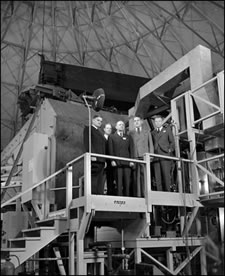 Tennessee Eastman officials and General Leslie R. Groves with Lawrence at the magnet for the 184-inch cyclotron in 1943.
Tennessee Eastman officials and General Leslie R. Groves with Lawrence at the magnet for the 184-inch cyclotron in 1943.
The big magnet's separators didn't work dependably until the end of 1942 — when a Rad Lab administrator suggested they be dubbed Calutrons — but a site for a pilot separation plant had already been chosen in Tennessee. In the spring of 1943 Lawrence and his boys descended on Oak Ridge to energize the construction of racetrack-shaped assemblies of Calutrons; Ed Lofgren designed a second-stage process for further purification of U-235.
By now all bomb work was under the aegis of the Manhattan Engineering District, headed by General Leslie Groves, previously noted for overseeing the construction of the Pentagon. Late in 1942, at Lawrence's urging, Groves chose Caltech and UC Berkeley theorist Robert Oppenheimer to head a secret laboratory in New Mexico.
Long before Hiroshima and Nagasaki, the Berkeley Rad Lab's active role in the war effort came to an end. In July 1944 the 60-inch cyclotron finished testing the stability of graphite rods destined for the giant plutonium-producing reactors at Hanford; it was time to return the machine to basic research. And it was also time, at last, to finish the 184-inch cyclotron — this time with government support. General Groves kicked in $170,000.
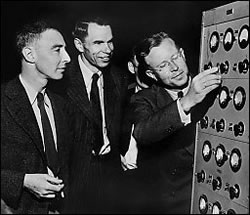 Ernest Lawrence, Glen T. Seaborg, and J. Robert Oppenheimer in early 1946 at the controls to the magnet of the 184-inch cyclotron, which was being converted from its wartime use to its original purpose as a cyclotron.
Ernest Lawrence, Glen T. Seaborg, and J. Robert Oppenheimer in early 1946 at the controls to the magnet of the 184-inch cyclotron, which was being converted from its wartime use to its original purpose as a cyclotron.
Whether the 184-inch would run afoul of the relativistic limit was a question the peripatetic Ed McMillan rendered moot when he returned from Los Alamos — where Lawrence had sent him early in 1943 — with a new idea for focusing accelerators. Instead of a continuous beam, particles would be emitted in pulses. As each bunch approached the speed of light, the accelerating frequency slowed to stay in sync with their ponderous mass.
At 12 minutes past midnight on November 1, 1946, Ernest Lawrence and “half the Lab” — its total staff had declined from a wartime high of 1,200 to fewer than 500 people — watched as the 184-inch “synchrocyclotron” produced deuterons at 200 MeV, equivalent to the 100 MeV proton energy Lawrence had dreamed of more than six years earlier.
Two months later the Manhattan District ceased to exist. The Atomic Energy Commission inherited its network of laboratories, which included Los Alamos and Argonne, Oak Ridge and Hanford, and, reluctantly at first, UC's Radiation Laboratory, which had played a key role in establishing the others. From now on, big science would depend on government funds.
NEXT: THE RAD LAB'S GREATEST ACCELERATORS
Berkeley Lab Science Roundup
Coming Soon: Cell Chips
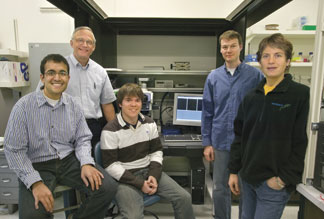 Berkeley researchers have developed a new and improved technique for attaching biological cells to nonbiological surfaces. Members of the team (from left) were Ravi Chandra, Richard Mathies, Erik Douglas, Matthew Francis and Carolyn Bertozzi.
Berkeley researchers have developed a new and improved technique for attaching biological cells to nonbiological surfaces. Members of the team (from left) were Ravi Chandra, Richard Mathies, Erik Douglas, Matthew Francis and Carolyn Bertozzi.
What DNA chips did for genetic analysis, cell chips — self-assembled arrays of cells on a thumbnail-sized chip — could do for a wide variety of applications, including biosensors, drug-screening technologies, the growing of artificial tissues and the design of neural networks. Toward this end, a team of Berkeley Lab researchers has developed a technique in which single strands of synthetic DNA are used to firmly fasten biological cells to non-biological surfaces. Under this new cell-adhesion system, developed by Ravi Chandra, Erik Douglas, Richard Mathies, Carolyn Bertozzi and Matthew Francis, the surface of a chip would be patterned with single-stranded DNA containing a specific nucleotide sequence. Select cells would then be coated with single-stranded DNA that contains a complementary sequence. Since only those cells with matching sequences would adhere to the DNA on the chip, different types of cells can be selectively targeted and attached to specific locations on the chip. While the mounting of single-stranded DNA on the surface of a chip is a well-established technology, this is the first time that single-stranded DNA has been attached to the surface of a biological cell.
Secrets of the Sea Yield Stronger Artificial Bone

From left, Antoni Tomsia, Sylvain Deville, and Eduardo Saiz have developed a technique that mimics the formation of sea ice to create a material that could lead to stronger artificial bone.
The next generation of artificial bone may rely on a few secrets from the sea. Berkeley Lab scientists developed a technique based on the way in which seawater freezes that enabled them to produce a porous, scaffolding-like material that is four times stronger than material currently used in synthetic bone. Variations of this technique could also be used in dental implants, airplane manufacturing, computer hardware, and other applications calling for strong but lightweight materials. Antoni Tomsia, Sylvain Deville, Eduardo Saiz and Ravi Nalla mimicked the formation of sea ice to create a ceramic composite that mirrors the intricate structure of nacre, a finely layered substance found in some mollusk shells, such as oysters and abalone.
When seawater freezes, crystals of pure ice form layers, while impurities such as salt and microorganisms are expelled from the forming ice and entrapped in channels between the ice crystals. This results in a layered wafer-like structure similar to nacre's. The Berkeley Lab researchers copied this process by suspending hydroxyapatite, the mineral component of bone, in water, then freezing the mixture. Just like the impurities in sea ice, the hydroxyapatite concentrates in the space between the ice crystals, creating layers and layers of nacre-like material. In the future, the Berkeley Lab researchers hope to use this technique to foster bone tissue regeneration.
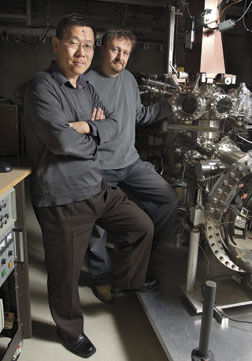 Experiments at the ALS by Berkeley Lab's Norman Mannella (right) and Stanford's Zhi-Xun Shen cast new doubts on any direct link between pseudogaps and high-temperature superconductivity.
Experiments at the ALS by Berkeley Lab's Norman Mannella (right) and Stanford's Zhi-Xun Shen cast new doubts on any direct link between pseudogaps and high-temperature superconductivity.
Pseudogap Role Debunked
Pseudogaps, a phenomenon of solid state physics, have been suspected by some scientists of playing a key role in the mystery of high-temperature superconductors. This idea has now been debunked. A team of Berkeley Lab and Stanford University scientists, working at the Advanced Light Source, has shown that pseudogaps occur in materials that are of a completely different nature from high-temperature superconductors. The team, which included physicist Norman Mannella, who holds a joint appointment at Berkeley Lab and Stanford, identified pseudogaps in manganites, manganese oxide materials that, below a certain critical temperature, become ferromagnetic and display colossal magnetoresistance (CMR). The pseudogaps found in these manganites are the same as those found in the high-temperature superconducting copper oxide materials, also known as cuprates, even though ferromagnetism is the antithesis of superconductivity. Pseudogaps are partial energy states in which some electrons can reside well above the energy gap from which electrons are supposed to be forbidden.
New Spin on Spin Currents: It's a Drag

Joe Orenstein, a physicist with Berkeley Lab and UC Berkeley, led a team that determine spin current is a Coulomb drag.
Futurologists and high-tech gurus anticipate that the next big thing in the electronics industry will be spintronics, devices based the spin of electrons that are smaller, faster and more versatile than today's devices, which are based on the charge of electrons. However, before the spintronic revolution can begin, scientists need a much better understanding of spin currents, created by the motion of electrons through a semiconductor. An important step in this direction was taken when a team of scientists led by Berkeley Lab's Joe Orenstein, and including Joel Moore, plus students Nuh Gedik and Chris Weber, demonstrated that, contrary to conventional scientific wisdom, spin current moves through a semiconductor at a slower rate than electrical charge current. Depending on the application, this effect, which is called “spin Coulomb drag,” could prove to be either an advantage or a disadvantage for future spintronic technologies.
DOE Awards Lab 'Outstanding' for Performance in 2005
Berkeley Lab's contract terms may have changed following last year's management competition, but the high quality of its performance did not. The Department of Energy has deemed the overall performance, including both science and operations, to be “outstanding” for fiscal year 2005, the same rating it received for the prior year.
DOE Berkeley Site Office Manager Aundra Richards shared the results recently with Lab managers, saying, “Thanks to all of you for an outstanding year. I'm very proud to be at this lab. You simply do an outstanding job in the science and in the support of it.”
The final overall rating for the Lab was 90.7 percent, a level considered “outstanding” by both the DOE and the University of California, which manages Berkeley Lab. Every scientific program supported by a DOE office received either an “excellent” or “outstanding” rating, for a grand total of 91.8 percent. Similar ratings were achieved in operations and administration, with an 87.5 percent total. DOE expressed some concerns about certain shortcomings in the areas of procurement and in environment, safety and health.
Richards in particular cited among the science and technology highlights: progress on the Molecular Foundry, the Advanced Light Source “top-off” upgrade,
carbon sequestration advances, an upgrade to the NERSC supercomputing center, contributions to the Large Hadron Collider project and to the RHIC accelerator program, and leadership in electricity grid analysis and energy reliability technology.
Chief Operations Officer David McGraw pointed in particular to the “enormous improvements” accomplished in the financial controls area following the hiring of Chief Financial Officer Jeffrey Fernandez. Other operations highlights included project and construction management performance, certified and validated EH&S programs, property management successes, and establishment of the Berkeley Lab Institute for employee development. The Infor-mation Technology Services Division was also cited for its cybersecurity achievements and cost savings.
Under the new management contract awarded to the University of California last fall, Berkeley Lab's ability to earn annual extensions beyond the current 5-year period is dependent upon strong performance in each of the evaluated areas. At least a “B-plus” must be achieved in order to receive extensions to the contract without having to recompete for it.
Chatterjee Retires: An Exemplary Career Of Service To Science and Berkeley Lab
After 36 years of exemplary service to this Laboratory and his field of research, Aloke Chatterjee, a radiation biophysicist in the Life Sciences Division, has retired. This does not mean that his familiar face will no longer be seen on the Hill. Chatterjee plans to continue his effort as an adviser for both administrative support and research.
“As a scientist, you cannot stop your brain from thinking,” he said. “I would like to help with the younger scientists.”
However, Chatterjee said he plans to take advantage of his retirement to do a lot of traveling with his wife of 36 years, Cathy. One of their first trips will be to take their grandchildren for a visit to New Delhi, where Chatterjee was born and raised.
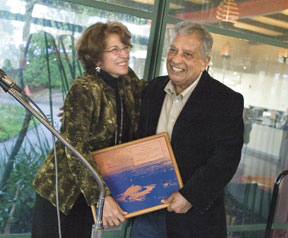
Mina Bissell and Aloke Chatterjee at the retirement celebration in his honor.
Chatterjee came to Berkeley Lab in 1970 after getting his Ph.D. in chemical physics from Notre Dame University. His bachelor's and master's degrees were obtained in physics from the University of Delhi. His research here has centered on the risks of low-dose ionizing radiation in the development of human cancers. He has specifically been interested in identifying the molecular mechanisms associated with damage to DNA, which are considered critical to public safety.
From 1989 to 2001, Chatterjee served as the deputy director of the Life Sciences Division. During much of this period, he also served as department head for the Radiobiol-ogy group in that division. Mina Bissell was the Life Sciences Division director during this time.
“Aloke was always the problem-solver, especially when it came to difficult and thorny personality issues,” Bissell said. “He was always constructive and kind, and was able to solve a great many problems behind the scenes. The Life Sciences Division and the Laboratory as a whole owe him a great debt.”
In addition to his contributions here at Berkeley Lab, Chatterjee has served on numerous review panels for DOE and NIH. His expertise in low-dose ionizing radiation led him to become the first director of NASA's Specialized Center of Research and Training (NSCORT), which, among other things, looked at the effects of radiation in space on biological functions at the cellular and molecular level. He served two consecutive five-year terms as NSCORT's director.
When asked about advice he had for young scientists just beginning their careers at Berkeley Lab, Chatterjee offered the following.
“The best advantage of working at this Laboratory is the human resources; we have so many excellent scientists over such a wide range of different disciplines,” he said. “Young researchers should try to interact with as many other scientists from related fields of interest as they can. This is what I did and I gained a lot from the experience.”
People, Awards, and Honors
Anil More is Manager Of Operations for OCFO
Chief Financial Officer Jeffrey Fernandez has announced the appointment of Anil More as manager of operations for the Office of the CFO. “Anil will play a major role in developing, planning, and managing all operational aspects of the OCFO,” Fernandez said. “He will have oversight for major organizational functions, including strategic planning and execution and major initiatives.” More has been at Berkeley Lab for 25 years in a variety of administrative and management roles.
Rob Johnson Will Head Homeland Security Office
Rob Johnson, long-time senior program manager at the Lab, will now head the Homeland Security Office. Johnson succeeds Bill Barletta, who has left Berkeley Lab to head the U.S. Particle Accelerator School at Fermilab. In his role, Johnson will oversee the laboratory's programs in homeland security, nonproliferation, counter-terrorism, and intelligence. Among his many prior responsibilities has been to connect the capabilities of Lab researchers to national scientific initiatives and to catalyze connections between the Lab and sponsoring agencies in Washington, D.C.
NERSC's Kramer is First Chair of Grid Council
National Energy Research Scientific Computing Center's (NERSC) General Manager Bill Kramer was recently elected the first chair of the Open Science Grid (OSG) Council. The council consists of representatives of member and partner organizations that are part of the initial formation of the OSG Consortium. The OSG is a nationwide community grid, built by research groups from U.S. universities and national laboratories, that enables collaborative research through distributed computing technologies.
Scientists, NERSC Get INCITE Awards
Berkeley Lab scientists and the National Energy Scientific Research Computing Center (NERSC) are the beneficiaries of recently announced Innovative and Novel Computational Impact on Theory and Experiment (INCITE) computing-time awards, sponsored by the Office of Science. Berkeley Lab scientists include Bill McCurdy and Tom Rescigno (Chemical Sciences), and Cameron Geddes, Carl Schroeder and Wim Leemans (Accelerator and Fusion Research). NERSC will be used by the Geddes team as well as UC San Diego Professor Michael Norman for an astrophysics study.
Lab Earth Scientists Win $3+ Million from DOE
Several investigators in Berkeley Lab's Environmental Remediation Program of the Earth Sciences Division were recently successful in securing over $3 million in funding from the Department of Energy's Environmental Management Science Program (EMSP). The funds allocated to Berkeley Lab represent a significant portion of the EMSP's research funding for this competition. Lab scientists were involved in six successful EMSP proposals, which focus on the use of advanced geophysical, geochemical, microbiological, and hydrological approaches for understanding complex subsurface phenomena.
Grants for Energy Use, Air Quality Study OK'd
The California Energy Commission recently approved two Berkeley Lab Environmental Energy Technologies Division projects that were submitted to the 2005 Environmental Exploratory Grant Program. Approved were Thomas Kirchstetter's “Past, Present and Future Measurement of Black Carbon Particles in the Atmosphere,” and Hashem Akbari's “Evaluation of Titanium Dioxide as an Air Pollutant Removing Catalyst.”
Sponsored by the Public Interest Energy Research Program's Environmental Area Program, the grant will fund research on the relationship between energy use and air quality, and the health benefits of removing pollutants from urban air.
In Memoriam
Biologist Jean Siri, Wife Of William, Dies at 85
Jean Brandenburg Siri, who worked at Berkeley Lab between 1946 and 1952 and was the wife of the late Lab nuclear physicist William Siri, died Jan. 20 at 85. She was a biologist in Medical Physics and overseer of the animal colony here. A pioneering environmental activist, Jean Siri was a persistent advocate for public access to East Bay parks and the eastern shore of San Francisco Bay. She was also mayor of El Cerrito twice during the 1980s and a member of the East Bay Regional Park District's board of directors from 1992 until her death.